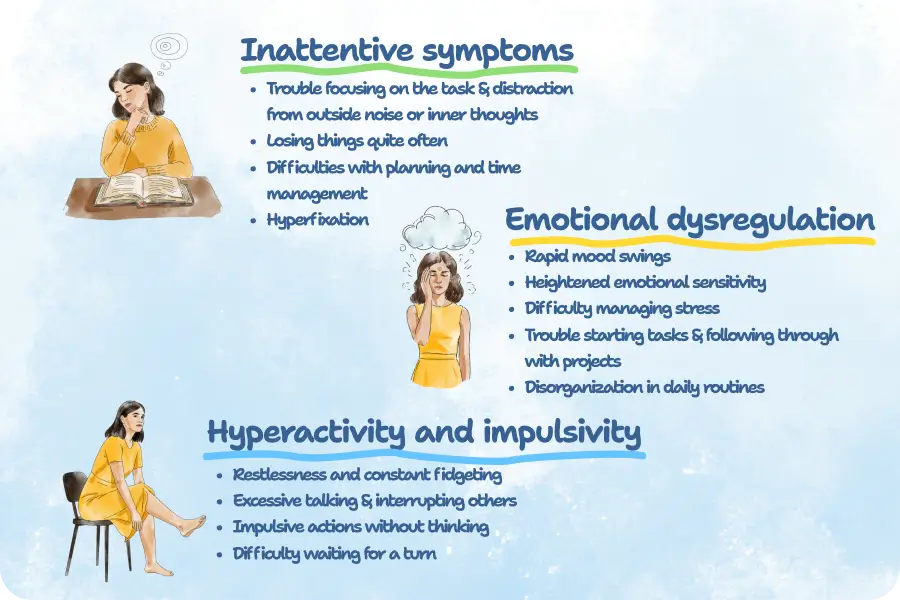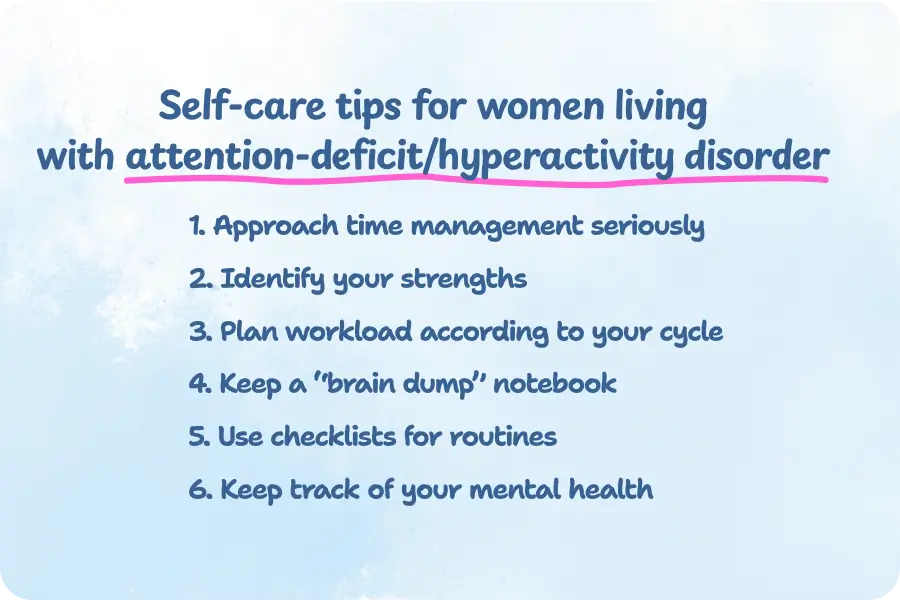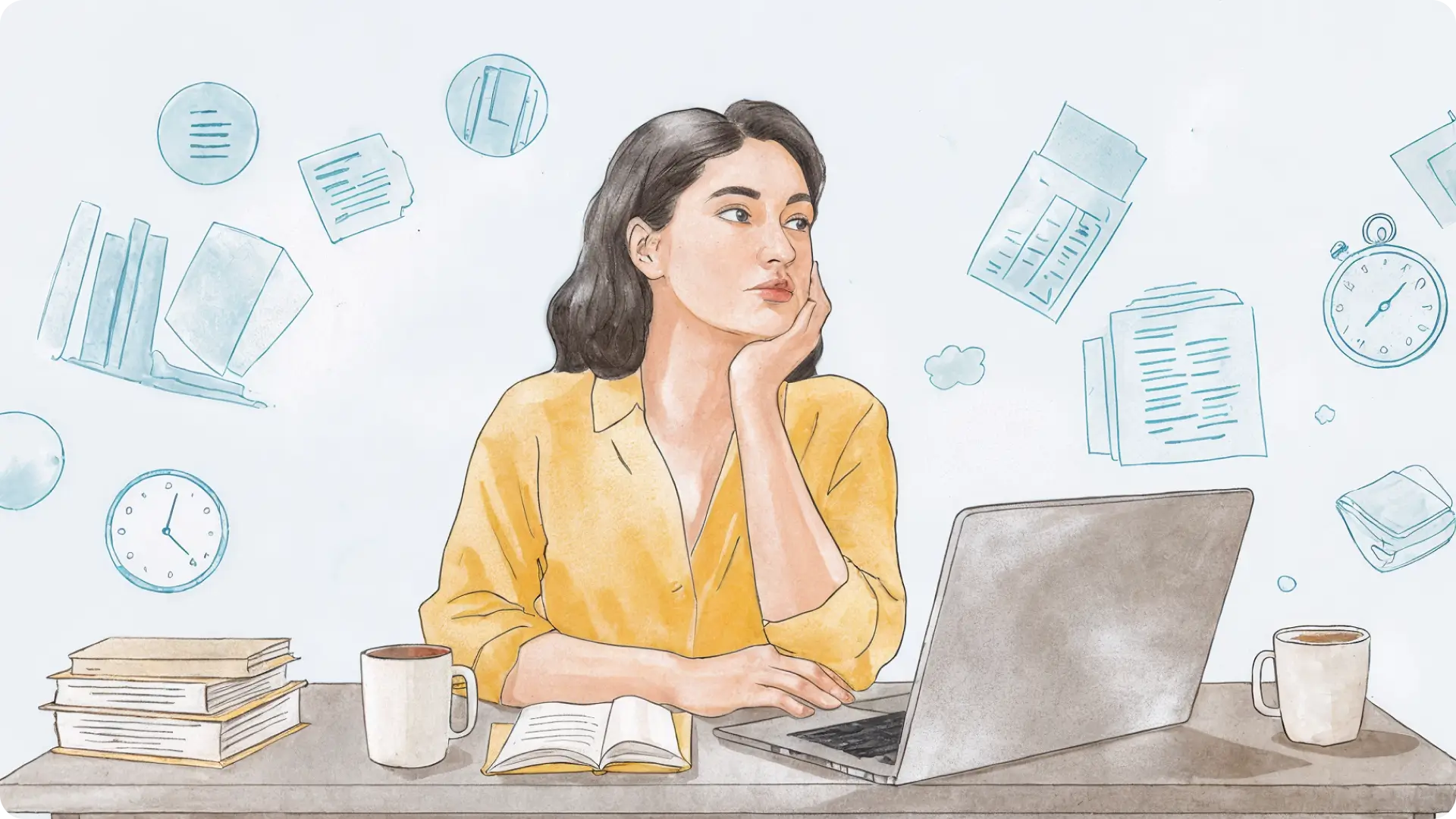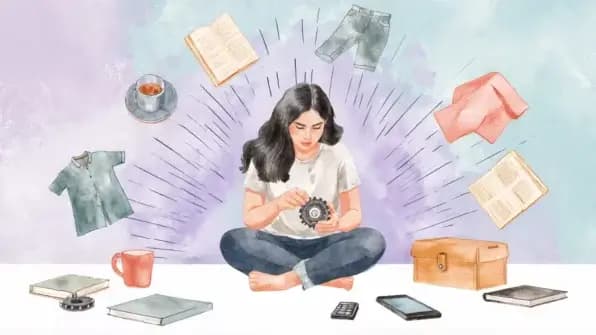Attention-deficit/hyperactivity disorder symptoms might seem universal for both sexes. However, studies have found that while women with ADHD experience the same symptoms as men, subtle differences in symptom and impairment patterns still emerge. [1]
Due to these differences, women can be diagnosed with ADHD after years of living without a proper diagnosis. So, in this article, we’ll explore how ADHD symptoms in women manifest and focus on coping strategies and treatment options.
What is ADHD, and why is it often missed in women?
Attention-deficit/hyperactivity disorder (ADHD) is a mental health condition that involves impulsivity, hyperactivity, difficulty concentrating, and emotional dysregulation. It might be missed in women because the signs are less obvious and harder to notice. They can sometimes be mistaken for stress, anxiety, or just being forgetful.
ADHD types
The Diagnostic and Statistical Manual of Mental Disorders, Fifth Edition (DSM-5), identifies 3 main types of ADHD:
- Inattentive type means that a person experiences a lack of attention and difficulty staying concentrated. Adult women with ADHD may have challenges organizing tasks and regularly forget important things.
- Hyperactive-impulsive type has difficulty controlling impulses, fidgets, and is restless. Such people may talk a lot and act without considering consequences.
- Combined type involves significant symptoms of both inattention and hyperactivity-impulsivity. Such women with ADHD meet the full criteria and might present the most complex profile for support.
To be diagnosed with a certain type, a person must exhibit at least six of its symptoms for a minimum of six months. At the same time, to have a combined type, you need to meet at least 12 symptoms (6 for the inattentive and 6 for the hyperactive-impulsive type).
Women compared to men
According to the research, females display more inattentive symptoms and fewer hyperactive and impulsive symptoms than males. [2] This means that in women’s ADHD, it’s more typical to live with an inattentive or combined type of the disorder.
Even more, symptoms of attention-deficit/hyperactivity disorder in women can be less overt, and young girls can develop coping strategies to handle them.
Most common ADHD symptoms in women
Manifestations and severity of ADHD symptoms in women may vary during their lifetime and even over the menstrual cycle, pregnancy, and menopause, according to the study published in BMC Psychiatry. [3] They typically fall under 3 main types: inattentive, hyperactive-impulsive, and emotional regulation symptoms, with inattentiveness being noticed the most often.
Inattentive symptoms
- Trouble focusing on the task & distraction from outside noise or inner thoughts. You can sit down to pay your bills, but get distracted by a buzzing notification. Ten minutes later, you’re deep into scrolling, the bills untouched.
- Losing things quite often. For instance, sometimes you may lose your keys in odd places, like the fridge.
- Difficulties with planning and time management. You might avoid tasks that require long effort. A big project can feel so overwhelming that you put it off until the last moment.
- Hyperfixation. When feeling inspired, you might spend hours organizing your bookshelf and forget about everything else.
In women, inattention may be stronger than in men. Forgetfulness, disorganization, and hyperfixation can stand out.
Hyperactivity and impulsivity in women
- Restlessness and constant fidgeting. You can’t sit still during a meeting, so you keep tapping your foot or playing with your pen.
- Excessive talking & interrupting others. You get excited telling a story and end up talking way longer than you meant to.
- Impulsive actions without thinking. You can agree to any crazy idea possible, from purchasing odd clothes to moving to another country right away.
- Difficulty waiting for a turn. Standing in line makes you feel restless, like you just can’t wait another minute.
Men with ADHD can be more aggressive and violent, and women might be sensitive to criticism and quick to react emotionally rather than aggressively.
Emotional dysregulation and executive dysfunction
- Rapid mood swings. You’re happy one minute and upset the next.
- Heightened emotional sensitivity. A small joke feels hurtful and stays in your head for weeks.
- Difficulty managing stress. One extra task makes you feel completely overwhelmed.
- Trouble starting tasks & following through with projects. You put things off and then find it tough to finish them until the deadline gets too close.
- Disorganization in daily routines. A situation when you start cooking but realize you forgot something important from the store is super-typical for you.
Women may be more emotionally sensitive, while men might seem irritable, withdrawn, or unmotivated.

How ADHD affects daily life for women
The everyday life of women with ADHD might be influenced by gender bias. For example, others may regard them as overly emotional or unreliable. Yet, difficulties with organization, focus, and emotional regulation are actually symptoms of the disorder.
Impact on relationships
Building relationships as a woman with ADHD can bring some arguments and misunderstandings to the couple. Partners may consider difficulty paying attention and being easily distracted as a lack of interest or commitment.
For example, if you forget the date and stay home instead of meeting your partner at a restaurant, it can be perceived as neglect. Also, emotional sensitivity can cause conflicts within your couple. A small comment like “you never listen” might feel very painful and lead to arguments.
However, building healthy and balanced relationships with women with an ADHD diagnosis is possible. For that, you can:
- Talk about your feelings regularly
- Use a shared calendar to plan dates
- Think about what you’re going to say before arguing
- Set relationship goals and stick to them
Workplace and career struggles
At work, women with ADHD can have challenges concentrating on one process, prioritizing tasks and meeting deadlines, sitting in one place for too long, or remembering meetings and agreements.
To stay more effective, you can:
- Use planners and checklists to remember all the tasks
- Take notes to remember details during meetings
- Keep your workplace clean
- Do not multitask
- Make use of particular sounds or music that aid in concentration
Parenting with ADHD
- Women with inattentive-type symptoms might forget appointments with doctors, school events, or helping with homework.
- Those with impulse-control symptoms can have challenges managing their anger when a child does something wrong.
- Emotional symptoms like irritability can turn into a lack of genuine connection and make the child feel distant from their parent.
This inconsistent parenting style can lead to a child’s unstable self-esteem or even result in childhood trauma. The problem can be even more noticeable if a child also has ADHD. Impulsivity of the mother and the child can lead to conflicts, while difficulties with remembering important things might result in low educational performance.
We asked Abigail Fernald, LCSW, to provide some tips on how a woman with ADHD can reduce the influence of the condition on her children. “When a woman with ADHD is parenting, self-awareness is the first and most powerful tool she can cultivate. By understanding her own patterns, such as emotional dysregulation, forgetfulness, or difficulty transitioning, she can create proactive systems that reduce chaos and increase emotional safety for her children. Using visual schedules, setting realistic expectations, and modeling self-compassion when mistakes happen can go a long way in fostering a stable environment. It’s also helpful to explain ADHD in age-appropriate ways, so children don’t internalize blame for parental stress. Most importantly, prioritizing her own nervous system regulation and asking for support (from a partner, friend, or professional) sends the message that it’s okay to take care of your mental health.”
ADHD in older women
The study has found that women with ADHD have an increased risk for (peri)menopausal symptoms. Also, sleep problems, anxiety, and depression contributed to worse executive functioning in postmenopausal women compared to premenopausal women. [4] As such, we can say that some symptoms of ADHD can become more severe for older women and further affect daily functioning.
How often do you behave impulsively?
Diagnosing ADHD in women
Boys (15%) are more likely to be diagnosed with ADHD than young girls (8%), so the ratio is about 1.875:1 [5]. However, it can’t bring us a holistic picture.
Why women are underdiagnosed
Women’s ADHD can be diagnosed much later in life or even remain undiagnosed. Researchers provide several reasons why it is so:
- Fewer obvious childhood symptoms. Women’s manifestations of ADHD may be less noticeable, so it’s more challenging to spot them in childhood.
- Different kinds of symptoms. Hyperactive symptoms in men are more likely to be diagnosed than women’s inattentiveness.
- Other mental illnesses. Women are more likely to experience anxiety disorders or depression, which can lead to undiagnosed ADHD because of overlapping mental health conditions.
- Different copying strategies. Adult women may overwork or rely too much on routines in an attempt to make up for their lack of focus and internal struggles. While they can consider it as something normal, it makes it tougher to notice ADHD patterns.
- Childhood trauma. Early experiences can lead to coping patterns that mask ADHD traits, such as overachievement, people pleasing, etc, which might lead to misdiagnosis or delayed diagnosis.
How is ADHD diagnosed in women?
To get a diagnosis, you need to visit a licensed mental health professional. Together, you’ll talk about your current or past symptoms and fill in special questionnaires to get a holistic picture of the situation.
There are currently no medical or laboratory tests that can definitively diagnose ADHD, such as a blood test or brain scan. Instead, diagnosis is based on a comprehensive clinical evaluation.
A qualified mental health professional will assess your symptoms using criteria from the Diagnostic and Statistical Manual of Mental Disorders (DSM-5) and may use structured interviews, rating scales, and input from people close to you. This helps ensure a thorough understanding of how your symptoms show up in daily life and how they’ve impacted your functioning over time.
Also, they need to take into account your sex and how ADHD symptoms may present differently in women. This way, the diagnosis will reflect your experiences accurately.
Questions to ask a doctor about adult ADHD symptoms
A qualified mental health provider can lead you through the whole process. Still, here are some questions you might overlook asking that can be rather helpful.
Before you get diagnosed with ADHD
- I have some difficulties with memory and attention. Can they be the signs of ADHD?
- Are there other conditions that can mimic ADHD in adults?
- I’ve experienced or still live with an eating disorder. Can it be somehow linked to ADHD?
- Should we discuss my childhood behavior or school performance to identify the diagnosis?
Also, always remember to say if you live with borderline personality disorder, bipolar disorder, substance abuse disorder, or any other conditions.
Once you find out that you live with high-functioning ADHD
- How can hormonal changes influence my executive function?
- Can I distinguish ADHD manifestations and stress-related cognitive challenges? How can it help me?
- What treatment would you recommend to me?
- Are there signs that I may need changes in treatment?
- Can ADHD get worse with age? Can I prevent it?
ADHD treatment and managing ADHD symptoms in women
Women’s ADHD can’t be cured completely. However, you can treat ADHD and reduce the influence of its symptoms on daily life. Medications, psychotherapy, implementing lifestyle strategies, and organizational tools may work well for many women.
ADHD medication options
To help women manage the symptoms of ADHD, doctors may prescribe medications to balance brain chemicals. There are a few categories:
- Stimulant medications
- Non-stimulant medications
- Antidepressants
Please, don’t try to pick medication on your own — your doctor can suggest the best option for your symptoms and overall emotional well-being. If you also have hormone imbalances, those should be taken into account, too.
Therapy and coaching
- Cognitive-behavioral therapy (CBT) helps women handle negative thoughts, overcome low self-esteem, and develop more consistent habits.
- Dialectical-behavioral therapy (DBT) allows patients to improve distress tolerance and regulate their emotions better.
- Family therapy can make life at home easier. It helps your close ones understand ADHD better and supports healthier ways to deal with impulsive moments.
- ADHD coaching is practical and hands-on. It helps you set goals, plan your day, and manage tasks without feeling constantly behind.
Lifestyle strategies
ADHD research has found that improved lifestyle choices may ameliorate symptoms of the disorder. [6] A structured daily routine allows women to benefit from ADHD perks (like excessive creativity or hyperfocus) while also avoiding its challenges.
Healthy diet
Some people with ADHD may feel frustrated when they need to cook something or decide what they need to eat. Also, forgetting to eat at all can be a typical symptom of ADHD in women.
To take care of your physical health and eat more consistently, it may be necessary to:
- Prepare meals in advance
- Find simple recipes you can repeat in 10 minutes
- Keep healthy snacks ready
- Set reminders to eat
- Plan a grocery list to avoid last-minute unhealthy choices
Regular sleep schedule
Your body can set its own internal clock if you go to bed and wake up at the same time every day. This could help you feel better and have more control over your emotions and mood.
Having a regular schedule can help with it even more because ADHD in women can make it hard to fall asleep, stay up, or stay asleep all night. This will “teach” your brain that it needs to rest at certain times and tell it when it’s time to be active.
Working out regularly
Women with ADHD may be able to control their mood and reduce their impulsiveness and hyperactivity by being active. Dopamine and norepinephrine, which are responsible for overall mental clarity, go up when you exercise regularly.
If you have trouble going to the gym on a regular basis, you could try going for long walks, doing yoga at home, or dancing. You can also work out with your friends and help each other. It will make things more fun and keep you going.
Organizational tools and apps
Breeze Wellbeing
This app allows you to develop coping mechanisms to stay productive and accept yourself as you are. It provides customizable routines where you can:
- Plan a new habit
- Set reminders
- Choose the number of times a week you want to practice
- Track progress
For example, if you want to meditate every day in the morning, simply use Breeze to schedule your sessions. Also, the app lets you journal your thoughts in the moments you feel worried, notice ADHD struggles with the mood tracker, and use relaxation games to feel much calmer and concentrated.
Notion
It’s a tool to plan everyday tasks and organize notes in a way that is comfortable for you. With Notion, you can:
- Make custom dashboards
- To-do lists
- Project trackers
- Share info with the team
- Use AI-powered features to simplify organization (which is particularly useful for women with ADHD symptoms).
For example, you want to plan a holiday and need to book a hotel, find tickets, create a list of things to take, and think about the work tasks to manage before. Notion allows you to keep everything in your head and remember even small details.
Forest
The app helps you improve focus and avoid getting distracted every few minutes on social media, push notifications, or messages. You need to keep the application open without using any other sites or apps.
It’s based on the Pomodoro technique: 25 minutes of work without distraction and 5 minutes of rest. After a few sessions, you can take a longer break.

Self-care tips for women living with attention-deficit/hyperactivity disorder
To handle inattentiveness and impulsivity, it’s essential to implement structure into daily life. Besides ADHD medications, you can do the following:
1. Approach time management seriously
Women with ADHD can lose track of time or get hyperfocused on something for too long. It might also be tough for some of them to estimate the time needed for a certain task. To succeed in time management and take more control of your life, try the following:
- Use time reminders. You can set an alarm for 4 hours once you start to do something engaging to remind yourself to eat. Or you can plan big events before the month starts and be ready for your mother’s birthday and a project deadline at work.
- Break tasks into small steps. While this tip might be efficient for many women, those with ADHD may benefit from it even more. If big projects make you feel frustrated, divide them into tiny milestones and tick each one off as you go. This can make the workload feel lighter.
- Set deadlines for all tasks. Even if your manager doesn’t tell you to do something by Tuesday, create a deadline on your own. It will let you avoid the frustrating task.
- Schedule extra minutes between tasks. This “buffer zone” will let you take some rest, shift your mind from one task to another, and reduce stress from constantly being in a rush. Just a few minutes to drink some tea can make a big difference.
- List your top daily tasks. Write down 2-3 key things you need to do, and concentrate on them instead of trying to manage everything at once. This approach can prevent you from feeling overwhelmed.
2. Identify your strengths
ADHD may bring benefits and specific perks, and it’s vital to acknowledge them to feel empowered. Among the following ADHD researches highlighted:
- adventurousness
- exploration
- courage
- energy
- creativity
- determination
- hyperfocus
- curiosity
- resilience [7]
When you’re having trouble focusing, think about how creative you are. You can turn your talking too much into charm and your impulsiveness into spontaneity.
3. Plan workload according to your cycle
Hormonal changes can make ADHD symptoms worse at certain times of the month. It can be harder to stay organized during these days, which can lead to challenges with efficiency or self-esteem.
First, you can try to when you feel most productive and time periods when you don’t to later align them with your cycle. Then, try to schedule lighter tasks or give yourself extra breaks when you know your energy is low.
Of course, things may not go perfectly. However, if you listen to your body and stay gentle with yourself, it can help you manage ADHD symptoms more effectively.
4. Keep a “brain dump” notebook
If your mind is full of thoughts about work, dinner, plans, or other people, it can feel really exhausting. To clear mental clutter, it makes sense to write every little worry down.
Your notes shouldn’t look perfect or make any sense. You don’t need to reread them as well. Just getting everything out of your head and onto paper can already make you less stressed.
For example, you can set aside 10 minutes in the morning and 10 minutes in the evening to note your thoughts. You can also carry a notebook with you or use digital alternatives (like journaling options from Breeze Wellbeing) to capture everything on the go.
5. Use checklists for routines
People with inattentive-type symptoms can forget small but important tasks (like taking vitamins or packing their bag). To reduce forgetfulness, it can be helpful to create morning, evening, or work routines. For example, your morning checklist can look like the following:
- Wake up and make your bed
- Drink a glass of water
- Take vitamins
- Shower and get dressed
- Eat breakfast
- Check your calendar for the day
- Pack your bag
- Set reminders for important appointments
6. Keep track of your mental health
Studies prove high comorbidity of ADHD in women with other disorders, including autism spectrum disorder, depressive disorder, bipolar disorder, anxiety disorders, disruptive mood dysregulation disorder, etc. [8] So if you notice frequent mood changes, permanent anxiety with no reason, or any other unusual states, it’s better to talk about it with your provider.
Expert Insight
“Distinguishing ADHD symptoms from those of other conditions, like anxiety, depression, or trauma, can be challenging, especially for women whose symptoms may have been masked or misinterpreted over time. One key difference is that ADHD symptoms (such as distractibility, impulsivity, and disorganization) typically begin in childhood, even if they weren’t recognized at the time. In contrast, conditions like anxiety or depression may emerge later and often fluctuate with external stressors. However, these conditions can also co-occur, which can further complicate the clinical picture. A qualified mental health professional can help sort through these layers by looking at the full history, current functioning, and emotional patterns. A comprehensive evaluation is essential because proper diagnosis is the foundation for effective support.”
Abigail Fernald
Mental health professional
Frequently asked questions
What is high-functioning ADHD in adult women?
This term means the symptoms aren’t very obvious, and people can handle everyday life well. They might have some trouble with focus, impulsivity, or emotions, but such people can live normal lives and use their creativity in positive ways.
Are women more likely to have the inattentive type?
Yes, women are more likely to have the inattentive or combined types of ADHD and experience forgetfulness, difficulty focusing, or disorganization.
Is ADHD in women genetic or hormonal?
ADHD is about 74% genetic. [9] While there’s no clear explanation of how it’s inherited, this disorder can stem from a combination of genetic factors, brain chemistry, and environmental factors. Hormonal changes can worsen the symptoms of ADHD or affect how they manifest. Yet, female hormones can’t cause the disorder itself or make it develop from scratch.
Sources
- Noemi M. Platania, Daniëlle E. J. Starreveld, Dora Wynchank, Aartjan T. F. Beekman, Sandra Kooij. “Bias by gender: exploring gender-based differences in the endorsement of ADHD symptoms and impairment among adult patients.” Front. Glob. Women’s Health, 20 March 2025
- Tamara Williams, Louise Horstmann, Laiba Kayani, Annabelle Xiao Hui Lim, Abigail Russell, Tamsin Ford, Ann John, Kapil Sayal, Anita Thapar, Kate Langley, Joanna Martin. “An item-level systematic review of the presentation of ADHD in females.” Neuroscience & Biobehavioral Reviews. 2025
- Young S, Adamo N, Ásgeirsdóttir BB, Branney P, Beckett M, Colley W, Cubbin S, Deeley Q, Farrag E, Gudjonsson G, Hill P, Hollingdale J, Kilic O, Lloyd T, Mason P, Paliokosta E, Perecherla S, Sedgwick J, Skirrow C, Tierney K, van Rensburg K, Woodhouse E. “Females with ADHD: An expert consensus statement taking a lifespan approach providing guidance for the identification and treatment of attention-deficit/ hyperactivity disorder in girls and women.” BMC Psychiatry. 2020
- Page CE, Soreth B, Metcalf CA, Johnson RL, Duffy KA, Sammel MD, et al. “Natural vs. surgical postmenopause and psychological symptoms confound the effect of menopause on executive functioning domains of cognitive experience.” Maturitas. (2023) 170:64–73. doi: 10.1016/j.maturitas.2023.01.007
- Danielson ML, Claussen AH, Bitsko RH, Katz SM, Newsome K, Blumberg SJ, Kogan MD, Ghandour R. ADHD Prevalence Among U.S. “Children and Adolescents in 2022: Diagnosis, Severity, Co-Occurring Disorders, and Treatment.” J Clin Child Adolesc Psychol. 2024
- Lange, Klaus. (2018). “Lifestyle and attention deficit/hyperactivity disorder.” 2. 22-30. 10.5283/mnhd.10.
- Nordby ES, Guribye F, Nordgreen T, Lundervold AJ. “Silver linings of ADHD: a thematic analysis of adults’ positive experiences with living with ADHD.” BMJ Open. 2023
- Gnanavel S, Sharma P, Kaushal P, Hussain S. “Attention deficit hyperactivity disorder and comorbidity: A review of literature.” World J Clin Cases. 2019
- Faraone SV, Larsson H. “Genetics of attention deficit hyperactivity disorder.” Mol Psychiatry. 2019 Apr;24
Disclaimer
This article is for general informative and self-discovery purposes only. It should not replace expert guidance from professionals.
Any action you take in response to the information in this article, whether directly or indirectly, is solely your responsibility and is done at your own risk. Breeze content team and its mental health experts disclaim any liability, loss, or risk, personal, professional, or otherwise, which may result from the use and/or application of any content.
Always consult your doctor or other certified health practitioner with any medical questions or concerns
Breeze articles exclusively cite trusted sources, such as academic research institutions and medical associations, including research and studies from PubMed, ResearchGate, or similar databases. Examine our subject-matter editors and editorial process to see how we verify facts and maintain the accuracy, reliability, and trustworthiness of our material.
Was this article helpful?









